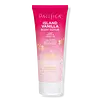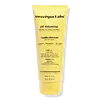What's inside
What's inside
 Key Ingredients
Key Ingredients

No key ingredients
 Benefits
Benefits

 Concerns
Concerns

 Ingredients Side-by-side
Ingredients Side-by-side

Water
Skin ConditioningJuglans Regia Shell Powder
AbrasiveHelianthus Annuus Seed Oil
EmollientGlycerin
HumectantCetyl Alcohol
EmollientGlyceryl Stearate
EmollientStearic Acid
CleansingJojoba Esters
EmollientBenzyl Alcohol
PerfumingSimmondsia Chinensis Seed Oil
EmollientSucrose
HumectantPrunus Amygdalus Dulcis Fruit Extract
Skin ConditioningRosa Canina Fruit Oil
EmollientVanilla Planifolia Fruit Extract
Skin ConditioningSalvia Officinalis Oil
MaskingLavandula Angustifolia Extract
Skin ConditioningChamomilla Recutita Extract
Skin ConditioningCamellia Sinensis Callus
AntimicrobialArnica Montana Flower/Rhizome/Root Powder
Tocopherol
AntioxidantPanthenol
Skin ConditioningLinum Usitatissimum Seed Oil
PerfumingGlycyrrhiza Glabra Root Extract
BleachingAllantoin
Skin ConditioningPapain
Skin ConditioningBromelain
Skin ConditioningMaltodextrin
AbsorbentGlycine Soja Sterols
EmollientGlyceryl Laurate
EmollientSodium PCA
HumectantPhenoxyethanol
PreservativeEthylhexylglycerin
Skin ConditioningParfum
MaskingWater, Juglans Regia Shell Powder, Helianthus Annuus Seed Oil, Glycerin, Cetyl Alcohol, Glyceryl Stearate, Stearic Acid, Jojoba Esters, Benzyl Alcohol, Simmondsia Chinensis Seed Oil, Sucrose, Prunus Amygdalus Dulcis Fruit Extract, Rosa Canina Fruit Oil, Vanilla Planifolia Fruit Extract, Salvia Officinalis Oil, Lavandula Angustifolia Extract, Chamomilla Recutita Extract, Camellia Sinensis Callus, Arnica Montana Flower/Rhizome/Root Powder, Tocopherol, Panthenol, Linum Usitatissimum Seed Oil, Glycyrrhiza Glabra Root Extract, Allantoin, Papain, Bromelain, Maltodextrin, Glycine Soja Sterols, Glyceryl Laurate, Sodium PCA, Phenoxyethanol, Ethylhexylglycerin, Parfum
Water
Skin ConditioningAloe Barbadensis Leaf Juice
Skin ConditioningSodium Cocoyl Isethionate
CleansingCocamidopropyl Hydroxysultaine
CleansingSodium Lauroamphoacetate
CleansingCaprylyl/Capryl Glucoside
CleansingGlycol Distearate
EmollientSodium Methyl Cocoyl Taurate
CleansingPropanediol
SolventButyrospermum Parkii Butter
Skin ConditioningHelianthus Annuus Seed Oil
EmollientCocos Nucifera Oil
MaskingPrunus Armeniaca Kernel Oil
MaskingSimmondsia Chinensis Seed Oil
EmollientPanthenol
Skin ConditioningBetaine
HumectantHydroxypropyl Guar Hydroxypropyltrimonium Chloride
Citric Acid
BufferingXanthan Gum
EmulsifyingTrisodium Ethylenediamine Disuccinate
Ethylhexylglycerin
Skin ConditioningBenzoic Acid
MaskingPhenoxyethanol
PreservativeParfum
MaskingWater, Aloe Barbadensis Leaf Juice, Sodium Cocoyl Isethionate, Cocamidopropyl Hydroxysultaine, Sodium Lauroamphoacetate, Caprylyl/Capryl Glucoside, Glycol Distearate, Sodium Methyl Cocoyl Taurate, Propanediol, Butyrospermum Parkii Butter, Helianthus Annuus Seed Oil, Cocos Nucifera Oil, Prunus Armeniaca Kernel Oil, Simmondsia Chinensis Seed Oil, Panthenol, Betaine, Hydroxypropyl Guar Hydroxypropyltrimonium Chloride, Citric Acid, Xanthan Gum, Trisodium Ethylenediamine Disuccinate, Ethylhexylglycerin, Benzoic Acid, Phenoxyethanol, Parfum
Ingredients Explained
These ingredients are found in both products.
Ingredients higher up in an ingredient list are typically present in a larger amount.
Ethylhexylglycerin (we can't pronounce this either) is commonly used as a preservative and skin softener. It is derived from glyceryl.
You might see Ethylhexylglycerin often paired with other preservatives such as phenoxyethanol. Ethylhexylglycerin has been found to increase the effectiveness of these other preservatives.
Helianthus Annuus Seed Oil is the oil derived from the seeds of a Sunflower. Sunflower seed oil is non-fragrant. It is an emollient, meaning it helps to soften the skin.
Sunflower seed oil contains many fatty acids. The fatty acids found in sunflower seeds include (from highest amount to least): linoleic acid, myristic acid, palmitic acid, stearic acid, arachidic acid, oleic acid, and linolenic acid.
These fatty acids help the skin create ceramides. Ceramides play a role in repairing the skin barrier.
Helianthus Annuus Seed Oil helps moisturize the skin. This in turn helps the skin look more rejuvenated and smoother.
Sunflowers are rich in vitamin E.
Historians believe Indigenous cultures of North America domesticated sunflowers before corn. Thus they relied on sunflower oil for a variety of uses. One such use is moisturizing skin and hair.
Sunflower seed oil may not be fungal acne safe. We recommend speaking with a professional if you have any concerns.
Learn more about Helianthus Annuus Seed OilPanthenol is a common ingredient that helps hydrate and soothe the skin. It is found naturally in our skin and hair.
There are two forms of panthenol: D and L.
D-panthenol is also known as dexpanthenol. Most cosmetics use dexpanthenol or a mixture of D and L-panthenol.
Panthenol is famous due to its ability to go deeper into the skin's layers. Using this ingredient has numerous pros (and no cons):
Like hyaluronic acid, panthenol is a humectant. Humectants are able to bind and hold large amounts of water to keep skin hydrated.
This ingredient works well for wound healing. It works by increasing tissue in the wound and helps close open wounds.
Once oxidized, panthenol converts to pantothenic acid. Panthothenic acid is found in all living cells.
This ingredient is also referred to as pro-vitamin B5.
Learn more about PanthenolParfum is a catch-all term for an ingredient or more that is used to give a scent to products.
Also called "fragrance", this ingredient can be a blend of hundreds of chemicals or plant oils. This means every product with "fragrance" or "parfum" in the ingredients list is a different mixture.
For instance, Habanolide is a proprietary trade name for a specific aroma chemical. When used as a fragrance ingredient in cosmetics, most aroma chemicals fall under the broad labeling category of “FRAGRANCE” or “PARFUM” according to EU and US regulations.
The term 'parfum' or 'fragrance' is not regulated in many countries. In many cases, it is up to the brand to define this term.
For instance, many brands choose to label themselves as "fragrance-free" because they are not using synthetic fragrances. However, their products may still contain ingredients such as essential oils that are considered a fragrance by INCI standards.
One example is Calendula flower extract. Calendula is an essential oil that still imparts a scent or 'fragrance'.
Depending on the blend, the ingredients in the mixture can cause allergies and sensitivities on the skin. Some ingredients that are known EU allergens include linalool and citronellol.
Parfum can also be used to mask or cover an unpleasant scent.
The bottom line is: not all fragrances/parfum/ingredients are created equally. If you are worried about fragrances, we recommend taking a closer look at an ingredient. And of course, we always recommend speaking with a professional.
Learn more about ParfumPhenoxyethanol is a preservative that has germicide, antimicrobial, and aromatic properties. Studies show that phenoxyethanol can prevent microbial growth. By itself, it has a scent that is similar to that of a rose.
It's often used in formulations along with Caprylyl Glycol to preserve the shelf life of products.
This oil comes from the seeds of the desert shrub called Jojoba. It is more commonly known as jojoba oil, a non-comedogenic oil.
Jojoba oil does not contain fragrance and has many fatty-acids, making it a great soothing ingredient.
It also contains Vitamin E, a great moisturizing ingredient. Vitamin E is also an antioxidant and protects your skin against oxidative damage.
This ingredient humectant properties, meaning it helps draw moisture from the air. This helps keep your skin hydrated.
While jojoba has antibacterial properties, it is only able to kill some strains of bacteria.
Studies also show it helps in wound healing. In fact, Indigenous cultures have used jojoba as a moisturizer and to help treat burns for centuries.
Fun fact: Jojoba oil similar to natural human skin sebum, so it has a great effect on dry skin. It is also promising with helping to regulate sebum production.
Due to its fatty acid content, Jojoba oil may not be fungal acne safe. We recommend speaking with a professional if you have any concerns.
Learn more about Simmondsia Chinensis Seed OilWater. It's the most common cosmetic ingredient of all. You'll usually see it at the top of ingredient lists, meaning that it makes up the largest part of the product.
So why is it so popular? Water most often acts as a solvent - this means that it helps dissolve other ingredients into the formulation.
You'll also recognize water as that liquid we all need to stay alive. If you see this, drink a glass of water. Stay hydrated!
Learn more about Water